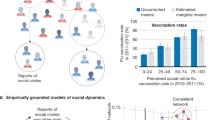Abstract
We introduce a system for sensing complex social systems with data collected from 100 mobile phones over the course of 9 months. We demonstrate the ability to use standard Bluetooth-enabled mobile telephones to measure information access and use in different contexts, recognize social patterns in daily user activity, infer relationships, identify socially significant locations, and model organizational rhythms.















Similar content being viewed by others
Notes
Using a 6-month old battery of a Nokia 6600 in a sparsely populated Bluetooth environment.
References
Addlesee M, Curwen R, Hodges S, Newman J, Steggles P, Ward A, Hopper A (2001) Implementing a sentient computing system. IEEE Comput Mag 34(8):50–56
Ashbrook D, Starner T, (2003) Using GPS to learn significant locations and predict movement across multiple users. Pers Ubiquit Comput 7:275–286
Bar-Noy A, Kessler I (1993) Tracking mobile users in wireless communication networks. IEEE Trans Inform Theory 39(6):1877–1886
Bhattacharya A, Das SK (1999) LeZi-update: an information-theoretic approach to track mobile users in PCS networks. In: Proceedings of the international conference on mobile computing and networking, Seattle, WA
Begole J, Tang J, Hill R (2003) Rhythm modeling, visualizations and applications. In: Proceedings of the UIST 2003. pp 11–20
Choudhury T (2004) Sensing and modeling human networks. Ph. D. Thesis, Program in Media Arts and Sciences, MIT, Cambridge, MA
Cox D, Kindratenko V, Pointer D (2003) IntelliBadge™: towards providing location-aware value-added services at academic conferences. In: Proceedings of UbiComp 2003, Lect Note Comput Sci 2864:264–280
Duda Ro, Hart PE, Stork DG (2001) Pattern classification. Wiley, New York
Eagle N, Pentland A (2005) Social serendipity: mobilizing social software. In: IEEE pervasive computing, special issue: the smart phone, pp 28–34
Himberg J, Korpiaho K, Mannila H, Tikanmäki J, Toivonen HTT (2001) Time series segmentation for context recognition in mobile devices. In: Proceedings of the IEEE international conference on data mining (ICDM 2001), San José, pp. 203–210
Holmquist LE, Falk J, Wigström J (1999) Supporting group collaboration with inter-personal awareness devices. J Pers Technol 3(1–2)
Kim SJ, Lee CY (1996) Modeling and analysis of the dynamic location registration and paging in microcellular systems. IEEE Trans Vehicular Technol 45(1):82–90
Laasonen K, Raento M, Toivonen H (2004) Adaptive on-device location recognition. In: Proceedings for pervasive, pp 287–304
Laibowitz M (2004) Parasitic mobility for sensate media, MS Thesis in Media Arts and Sciences, MIT, Cambridge
LaMarca A, Chawathe Y, Consolvo S, Hightower J, Smith I, Scott J, Sohn T, Howard J, Hughes J, Potter F, Tabert J, Powledge P, Borriello G, Schilit B (2005) Place lab: device positioning using radio beacons in the wild. In: Proceedings of the third international conference on pervasive computing, May 2005
Lamming M, Newman W (1992) Activity-based information retrieval: technology in support of personal memory. IFIP Transact A-14:68–81
Liao L, Fox D, Kautz H (2004) Learning and inferring transportation routines. In: Proceedings for the national conference on artificial intelligence (AAAI-04), San Jose, CA
Mäntyjärvi J, Himberg J, Kangas P, Tuomela U, Huuskonen P (2004) Sensor signal data set for exploring context recognition of mobile devices. In: Workshop “Benchmarks and a database for context recognition” in conjunction with the 2nd international conference on pervasive computing (PERVASIVE 2004), April 18–23, Linz/Vienna, Austria
Paulos E, Goodman E (2004) The familiar stranger: anxiety, comfort, and play in public places. In: Proceedings of CHI 2004, pp 223–230
Raento M, Oulasvirta A, Petit R, Toivonen H (2005) ContextPhone—a prototyping platform for context-aware mobile applications. IEEE Pervasive Comput 4(2):51–59
Roth J, Unger C (2000) Using handheld devices in synchronous collaborative scenarios. In: Proceedings of the second international symposium on handheld and ubiquitous computing (HUC), Bristol, UK
Schilit B, Adams N, Gold R, Tso M, Want R (1993) The ParcTab mobile computing system. In: Proceedings of the fourth workshop on workstation operating systems, pp 34–39
Singh P, Williams W (2003) LifeNet: a propositional model of ordinary human activity. In: Proceedings of the workshop on distributed and collaborative knowledge capture (DC-KCAP) at K-CAP 2003
Want R, Hopper A, Falcao V, Gibbons J (1992) The active badge location system. ACM Trans Inform Syst 10:91–102
Wolf J, Guensler R, Bachman W (2001) Elimination of the travel diary: an experiment to derive trip purpose from GPS travel data. In: Proceedings from the transportation research board 80th annual meeting, Washington DC
Weld D, Anderson C, Domingos P, Etzioni O, Gajos K, Lau T, Wolfman S (2003) Automatically personalizing user interfaces. In: Proceedings of the international joint conference on artificial intelligence (IJCAI03), Acapulco, Mexico
http://news.bbc.co.uk/1/hi/business/4257739.stm (verified April 13, 2004
http://www.bluetoothsig.com/emailfiles/Zelos.pdf (verified April 13, 2004)
Acknowledgements
The authors would like to express their gratitude to Wen Dong, Stephen Guerin, Tony Pryor, and Aaron Clauset. We would also like to thank Hari Pennanen and Nokia for their support. Finally, Mika Raento deserves particular recognition as the architect of Context and whose efforts were instrumental to this research.
Author information
Authors and Affiliations
Corresponding author
Rights and permissions
About this article
Cite this article
Eagle, N., (Sandy) Pentland, A. Reality mining: sensing complex social systems. Pers Ubiquit Comput 10, 255–268 (2006). https://doi.org/10.1007/s00779-005-0046-3
Received:
Accepted:
Published:
Issue Date:
DOI: https://doi.org/10.1007/s00779-005-0046-3




